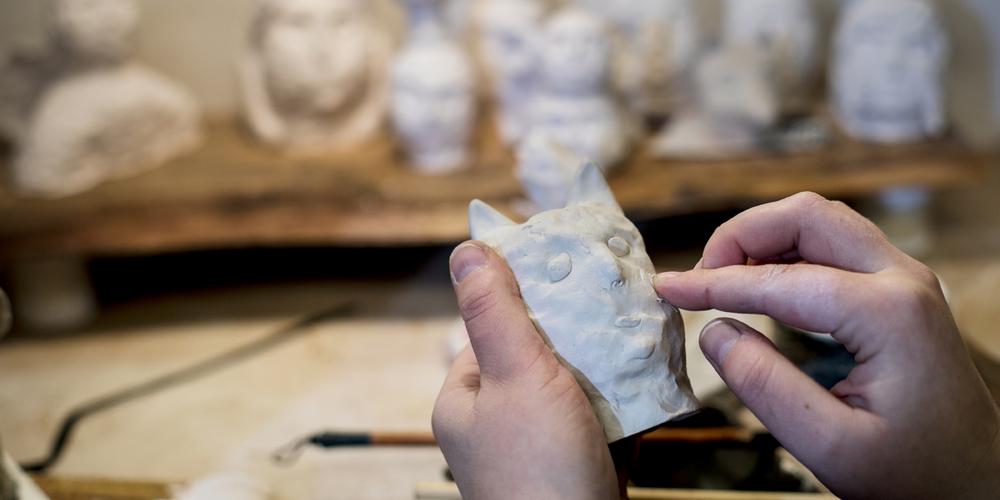
Malou makes creatures with her hands. HDK-Valand gave her the chance
She applied to HDK-Valand in order to explore her artistic side. A couple of years after graduating, Malou Larsson is still on that same path. Her dream is to be able to take ceramic art into the forest and build there site-specific works that more or less grow out of the earth.
When Malou Larsson was growing up in Örby, a little village south-east of Gothenburg, she was a football player with no plans for a future in the arts. But something happened in lower secondary school, and she started staying late in the art studio even after class was over. “I stayed on after everyone else had left and wanted to get help with my assignments,” she says.
The road to HDK-Valand
Getting involved in ceramic arts wasn’t even on her radar. Not at that time. It wasn’t until she took a trip to Cuba and South America as an adult that the idea occurred to her.
“When I saw their utilitarian objects,” says Malou, “it struck me that this was something I wanted to work with. I had never worked in clay, but I applied to the ceramics programme at the community college in Grebbestad.”

Since then, she has never once doubted her choice of career: “Nope, never. After Grebbestad, I spent two years at Formakademin [design school] in Lidköping, always with the feeling that I would eventually end up at HDK-Valand. I just wanted a chance to work with clay, to continue exploring the material and take it as far as I could,” she says.
“All of the programmes I’ve attended have been superb, but the ones in Grebbestadand Lidköping are actually more traditional pottery programmes – with lots of technique and lots of throwing pots.”
The making of Malou’s creatures
Today Malou has found her stride. For one thing, she has gotten a great deal of attention for her creatures, as she calls them, and has been given the chance to display her work in both gallery shows and juried exhibitions. “It was during my thesis project at HDK-Valand that I really found my own expression,” she says. “I had made several smaller ceramic heads before, but wanted to go up in scale and to work with glazes. So I got to work, dug in with my hands and tried not to think so much.”
The result was five large heads – five creatures – with different, often ambiguous and dark, emotional expressions. Nowadays these creatures number in the hundreds, and many of them have had to be relocated to Örby for storage. Malou doesn’t in fact want to be separated from them, but there’s simply no longer room for them in the workshop she has been sharing in Gothenburg with seven other ceramic artists since 2019.

The workshop is in the old sugar mill at Klippan. It was here Malou relocated her work immediately after the completion of her studies at HDK-Valand. She enjoys having other ceramic artists nearby and having a context in which to work.
The programme paved the way
It was the same thing while she was studying. Her classmates and teachers at HDK-Valand were very important to her. “Just getting to be in a ceramic context for such a long time was valuable,” says Malou. “You have your class and you get to see what others are doing, which in turn makes it easier to see yourself, what you’re doing and who you are. The teachers serve as models, which is totally essential for realising that it’s actually possible – that you can actually work as a ceramic artist.”
Because it is possible. Very possible, in fact. Malou has a lot going on this spring. For one thing, she is a guest member of the artisan-driven shop Sintra, where she has seen so much demand for her works that they’ve run out of stock and she’s had to make new ones. She has also been invited to contribute to this summer’s exhibition Portrait of a Place at the Not Quite gallery in Fengersfors. She looks forward to the exhibition and appreciates the chance to work with the place in mind. “It’s going to be super cool to get to show my work there,” she says. “The plan is to build big.”
The dream scenario is to some day in the future be able to do an entire exhibition of her own that relates to a particular place – especially if it’s in the forest. Undeniably, it holds an important place in Malou’s life. “Imagine getting to do an exhibition of these creatures out in the woods,” she says. “To get to make new trails, build the creatures directly on the site and create a context for them to inhabit. It would be fantastic.”
By Camilla Adolfsson

